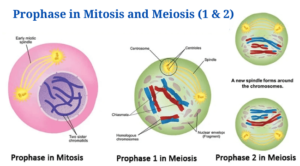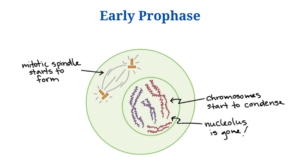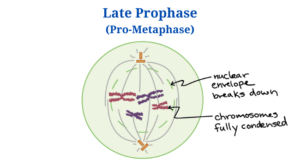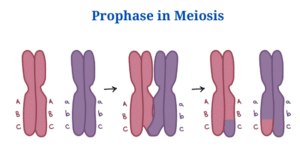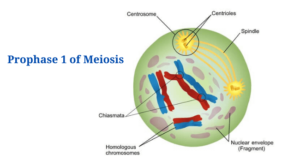Definition Prophase
For both mitosis and meiosis, prophase is the phase that follows interphase and is usually the first and longest phase in the cell cycle. The chromosomes are visible during this phase of DNA unwinding and chromatin condensation.
What Happens in Prophase?
- During prophase, the DNA that was generated during the interphase phase is separated, resulting in the formation of two identical daughter cells.
- During interphase, the chromatins generated by the combination of DNA and proteins condense.
- The chromatins coil and become solid during condensation, generating visible chromosomes.
- The chromosomes are made up of a single bit of DNA that has been arranged.
- Sister chromatids are chromosomes that are arranged in an X configuration.
- Sister chromatids are pairs of identical DNA copies that are connected at a centromere.
- At the cell’s opposing ends, mitotic spindles begin to develop.
- Microtubules are lengthy proteins that make up microtubules.
- The sister chromatids are separated into two cells by the mitotic spindles.
Image Source: Ali Zifan (Wikipedia) and Ali Zifan (Wikipedia).
In Mitosis, the prophase is the first stage of the cell cycle.
Prophase in Mitosis
Prophase is the first phase of mitosis in animal cells and the second phase of mitosis in plant cells.
Chromosome condensation
- This is a method through which the DNA that is generated during interphase gets condensed.
- DNA replication occurs during the interphase stage, which consistently entangles (intertwines) the DNA molecules for simple separation during mitosis.
- The compacting of chromatin into well-defined rod-shaped structures known as chromatins is known as chromatosome condensation.
- Chromatid resolution is a mechanism that permits structural reorganisation to separate identical sister chromatids.
- To prevent damage and breakage induced by the power of pulling microtubules and cytoplasmic pulls experienced during mitosis, condensation generates robust, elastic chromosomes.
- Condensins complexes, which include condensins and topoisomerase, help to condense chromosomes.
- Topoisomerase 2, in particular, aids in the relaxation and unlinking of supercoils generated during interphase, as well as the cutting and releasing of the DNA duplex.
- Condensation of chromosomes results in the formation of two X-shaped sister chromatids that are connected at a centromere.
- Condensins are complex proteins that play a critical function in the cell cycle, specifically in chromosomal separation, chromosome condensation, chromosome structural integrity, and DNA topographical resolution during interweaving.
Image Source: Khan Academy.
Movement of Centrosome
- Centrosome movement is a term used to describe the movement of centrosomes.
- Microtubules, which act by recruiting tubulins, are found at the centromere.
- Tubulins do their job by bringing microtubules into the nucleus.
- The centromeres that are duplicated during interphase shift further from the cell’s opposing poles.
- Motor proteins linked with the centromere are responsible for the movement.
- During chromatin separation, the centromere associated motor proteins track centromere movement and spindle development.
- To move along the microtubules, the motor proteins transform chemical energy in the form of ATP into mechanical energy.
- This aids in the movement of centromeres to opposite poles.
Formation of mitotic spindles – mitotic spindles are fibrous
- During separation, the replicated centrosomes are held in place by the interphase microtubules.
- Centrosomes travel to opposing poles of the cell when they separate, mediated by radial microtubules called Kinetochore located on each centrosome.
- Interpolar microtubules on both centrosomes interact with one another and link the sets of microtubules to form the basic structure of mitotic spindles.
- The chromosomes nucleate the microtubule assembly into the mitotic apparatus in cells without centrioles.
- Plants create mitotic spindles in a somewhat different way.
- At the foci, microtubules congregate at the cell’s opposite poles and begin to create the spindle apparatus.
- As the cell cycle progresses, the mitotic spindles eventually split the sister chromatids.
- Hundreds to thousands of fibrous microtubules and microtubule-associated proteins (MTP) make up the mitotic spindles, which are involved in the nucleation, transportation, dynamics, and cross-linking of microtubule networks.
Image Source: Khan Academy.
Beginning of nucleoli breakdown
- Part of the nucleus where ribosome synthesis takes place disappears during late prophase (prometaphase).
- This is a sign that the nucleus is beginning to degrade.
- The cell subsequently diverts its energy away from its metabolism and toward cell division mechanisms.
- The final chromosomal condensation occurs at this stage, resulting in an extremely compact chromosome.
- The nuclear envelope also disintegrates, allowing the chromosomes to be released.
- The mitotic spindles continue to expand, and some interpolar microtubules begin to grasp the chromosomes.
Prophase in Meiosis
- Meiosis is a little longer process than mitosis because it involves the separation of chromosomes in two rounds.
- Because prophase is divided into two phases, prophase I and prophase II, the procedure takes longer.
- Prophase I is a lengthy process that entails the pairing of homologous chromosomes and the exchange of genetic data. It distinguishes zwischen mitosis and meiosis.
- The mitotic prophase is quite similar to prophase II.
Image Source: Khan Academy.
Prophase I
This is when homologous chromosomes are paired and DNA is exchanged to generate recombinant chromosomes. Prophase I is divided into five stages.
These are some of them:
Leptotene : The first stage of prophase I and the shortest phase of prophase I is leptotene.
- It is the condensation step of a replicated chromosome.
- The chromosomes condense and become compact and transparent, allowing sister chromatids to be distinguished.
- The chromosomes resemble strings with beads, which are called chromomeres.
- The nuclear envelopes are linked to each of the sister chromatids.
Zygotene : also known as zygonema.
- This is the stage when homologous chromosomes join together to form chromosomal pairs, a process known as synapsis. There are four chromatids in each pair of chromosomes (tetrads).
- Synaptic associations arise up and down the chromosome, forming a synaptonemal complex with a zipper-like structure generated by chromatid coils.
- The synaptonemal complex aids synapsis by binding the aligned chromosomes together.
- They create four chromatids, known as tetrads or bivalents, after the homologous pairs synapse (two pairs).
Pachytene : Pachytene is the phase in which genetic materials pass over between non-sister chromatids, or pairs of homologous chromosomes. Chiasmata are formed as a result of this.
- Synapsis, the attachment established by the chromatid in a homologous chromosome, is used to cross across.
- Because of the interchange of genetic elements between the mother and father, the synapses complete the crossing over of genetic information, resulting in a variance in the genetic materials.
- Sister chromatid separation occurs, but homologous chromosomes stay linked, forming a thick complex known as the synaptonemal complex.
- The synaptonemal complex facilitates the creation of chiasma, which allow alleles to cross across in tiny chromosomal areas.
Diplotene: The synaptonemal complex vanishes at this stage, while the homologous pairs remain linked at the chiasmata.
- The synaptonemal complex disintegrates between the two chromosomal arms, causing the arms to repel one other.
- This causes the chromosomes to drift apart while yet being held together by the chiasmata.
- The chromosomes then begin to uncoil slowly, and the chiasmata may be observed moving close to the ends of the chromatids under a microscope. Terminalization is the word for this process.
Diakinesis: Diakinesis is the prophase I’s fifth and final phase. It prepares the cell to enter metaphase.
- It occurs after the chromatids have contracted and the sister chromatids have become bivalent tetrads, as seen under a microscope.
- The chiasmata ultimately reach the end of the chromosomes’ chromatid arms, completing terminalization.
- The chromosomes get increasingly condensed, but the chiasmata keep them attached, so they can’t migrate any closer to the poles.
- The nucleolus and nuclear envelope disintegrate at this point, allowing the centrioles (centrosome-forming microtubules) that make up the mitotic spindle to freely travel alongside the residual spindles generated during mitosis
Prophase II
- The nuclear envelope is broken down and chromosomal condensation occurs during this phase.
- It also entails the centrosomes migrating apart and a spindle developing between them.
- The chromosomes are captured by these spindles, which are effectively microtubules.
- The difference between this prophase and that of mitosis is that prophase II occurs with a haploid number of chromosomes, whereas mitotic prophase occurs with a diploid number of chromosomes.
- In telophase I, the chromosomes begin to decondense.
Click Here for Complete Biology Notes
Prophase in Mitosis and Meiosis Citations
- https://www.ncbi.nlm.nih.gov/pmc/articles/PMC4962293/
- https://pubmed.ncbi.nlm.nih.gov/13351623/
- http://www.phschool.com/science/biology_place/biocoach/mitosisisg/prophase.html
- https://www.nature.com/scitable/definition/prophase-189/
- https://study.com/academy/lesson/mitosis-i-the-mitotic-spindle.html#:~:text=The%20mitotic%20spindle%20is%20a,organizing%20center%20during%20cell%20division.
- https://www.khanacademy.org/science/biology/cellular-molecular-biology/mitosis/a/phases-of-mitosis
- https://bio.libretexts.org/Bookshelves/Human_Biology/Book%3A_Human_Biology_(Wakim_and_Grewal)/07%3A_Cell_Reproduction/7.3%3A_Mitotic_Phase_-_Mitosis_and_Cytokinesis
- https://www.sciencedirect.com/topics/medicine-and-dentistry/mitosis-spindle
- https://teaching.ncl.ac.uk/bms/wiki/index.php/Meiosis_prophase_1#:~:text=Diakinesis%20is%20the%20final%20step,most%20condensed%20form%20during%20diakinesis.
- https://science.sciencemag.org/content/301/5634/785/tab-figures-data
- http://www.phschool.com/science/biology_place/biocoach/meiosis/proi.html#:~:text=During%20prophase%20I%2C%20they%20coil,give%20rise%20to%20genetic%20recombination.
Related Posts
- Phylum Porifera: Classification, Characteristics, Examples
- Dissecting Microscope (Stereo Microscope) Definition, Principle, Uses, Parts
- Epithelial Tissue Vs Connective Tissue: Definition, 16+ Differences, Examples
- 29+ Differences Between Arteries and Veins
- 31+ Differences Between DNA and RNA (DNA vs RNA)
- Eukaryotic Cells: Definition, Parts, Structure, Examples
- Centrifugal Force: Definition, Principle, Formula, Examples
- Asexual Vs Sexual Reproduction: Overview, 18+ Differences, Examples
- Glandular Epithelium: Location, Structure, Functions, Examples
- 25+ Differences between Invertebrates and Vertebrates
- Lineweaver–Burk Plot
- Cilia and Flagella: Definition, Structure, Functions and Diagram
- P-value: Definition, Formula, Table and Calculation
- Nucleosome Model of Chromosome
- Northern Blot: Overview, Principle, Procedure and Results

